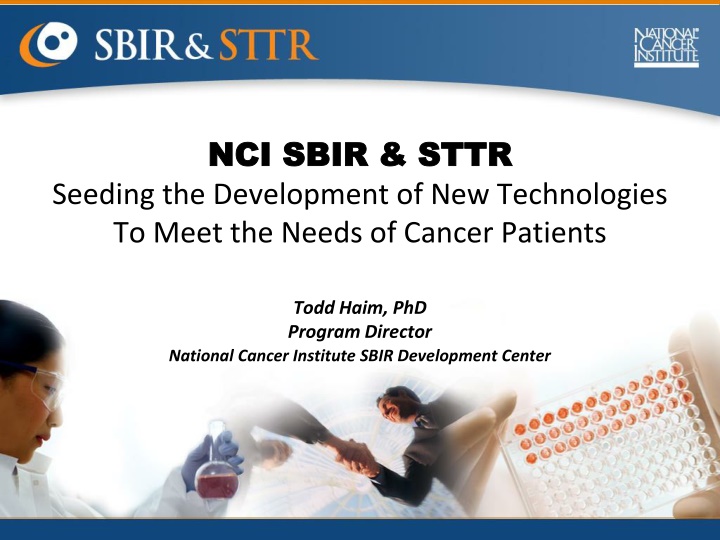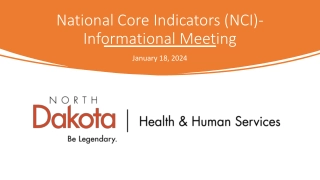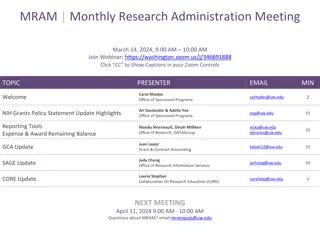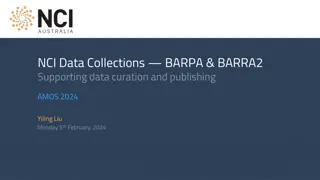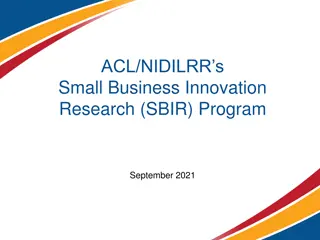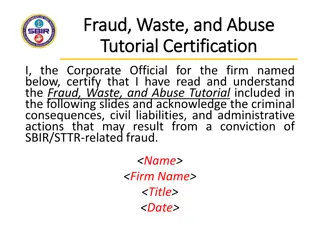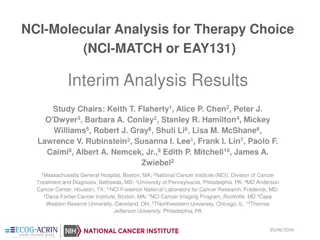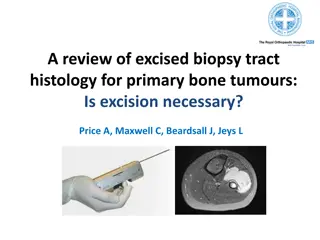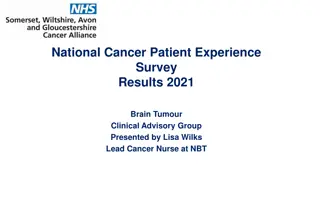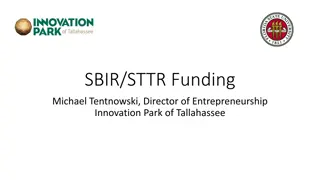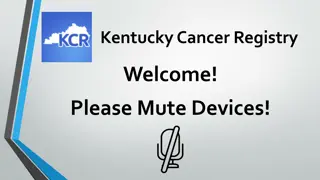NCI SBIR & STTR Seeding New Technologies for Cancer Patients
This content introduces the National Cancer Institute's SBIR Development Center, highlighting funding opportunities, initiatives, program staff, and core activities. The center aims to support the development of innovative technologies to meet the needs of cancer patients through grants and contracts. It outlines the focus areas, expert staff, and key activities such as central oversight, guidance, outreach, networking, and funding efforts in emerging technology areas.
Download Presentation

Please find below an Image/Link to download the presentation.
The content on the website is provided AS IS for your information and personal use only. It may not be sold, licensed, or shared on other websites without obtaining consent from the author.If you encounter any issues during the download, it is possible that the publisher has removed the file from their server.
You are allowed to download the files provided on this website for personal or commercial use, subject to the condition that they are used lawfully. All files are the property of their respective owners.
The content on the website is provided AS IS for your information and personal use only. It may not be sold, licensed, or shared on other websites without obtaining consent from the author.
E N D
Presentation Transcript
NCI SBIR & STTR NCI SBIR & STTR Seeding the Development of New Technologies To Meet the Needs of Cancer Patients Todd Haim, PhD Program Director National Cancer Institute SBIR Development Center
Todays Presentation NCI SBIR Development Center Funding Opportunities and SBIR Contracts NCI SBIR Initiatives Tips on Applications 2 @NCIsbir Leave Feedback: bit.ly/NCIsbirFeedback
NCI SBIR Development Center Program Staff Michael Weingarten,MA Director NCI SBIR Development Center Andrew J. Kurtz,PhD Lead Program Director Biologics, Small Molecules, Nanotherapeutics, Molecular Diagnostics, Bridge Award Greg Evans,PhD Lead Program Director Cancer Biology, E-Health, Epidemiology, Research Tools Patricia Weber, DrPH Program Director Digital Health, Therapeutics, Biologics, SBIR Investor Forum, FRAC Workshop Jian Lou, PhD Program Director In-Vitro Diagnostics, Theranostics, early-stage drug development , Bioinformatics, FRAC Workshop Deepa Narayanan, MS Program Director Todd Haim, PhD Program Director Cancer Imaging, Clinical Trials, Radiation Therapy, SBIR Investor Forum, FRAC Workshop Small Molecules, Biologics, Immunotherapeutics, Theranostics, SBIR Investor Forum, FRAC Workshop Ming Zhao, PhD Program Director Amir Rahbar, PhD, MBA Program Director Cancer Diagnostics & Therapeutics, Cancer Control & Prevention, Molecular Imaging, Bioinformatics, Stem Cells In-Vitro Diagnostics, Biologics, Therapeutics, Proteomics, SBIR Investor Forum Christie Canaria, PhD Program Manager Jonathan Franca-Koh, PhD, MBA Program Director Cancer Biology, Biologics, Small Molecules, Cell Based Therapies ncisbir@mail.nih.gov sbir.cancer.gov @NCIsbir Cancer/Biological Imaging, Research Tools, Devices, Scientific Communications, and I-Corps at NIH Kory Hallett, PhD AAAS Science & Technology Policy Fellow Monoclonal Antibodies, Immunotherapy, Biologics, and Program Analysis @NCIsbir Leave Feedback: bit.ly/NCIsbirFeedback
NCI SBIR Development Center: 5 Core Activities CENTRAL OVERSIGHT. All 400+ NCI SBIR/STTR awards at NCI are administered by the SBIR Development Center GUIDANCE. Help applicants prepare for their application, resubmission, and discuss funding options OUTREACH. Attend conferences and workshops, visit state-based organizations, and universities to raise awareness of the program NETWORKING. We maintain a network of investors, and facilitate connections between NCI SBIR portfolio companies and potential third-party investors/strategic partners FUNDING: Seed emerging technology areas by developing targeted funding opportunities either as grants or contracts @NCIsbir Leave Feedback: bit.ly/NCIsbirFeedback
Funding Opportunities Investor-Initiated Solicitations BISTI Bridge award Contracts 5 @NCIsbir Leave Feedback: bit.ly/NCIsbirFeedback
Investigator-Initiated Grants Omnibus Solicitations (Phase I, Phase II, FastTrack) PA-16-302 (SBIR) and PA-16-303 (STTR) Direct to Phase II Solicitation PAR-14-088 (SBIR only) We encourage applications for any topic within the NIH mission Due September 5, January 5, April 5 6 @NCIsbir Leave Feedback: bit.ly/NCIsbirFeedback
Early Stage Development of Technologies in Biomedical Computing, Informatics, and Big Data Science Goal: To support small businesses that propose development of a broad base of innovative technologies in biomedical computing, informatics, and Big Data Science that will support rapid progress in areas of scientific opportunity in biomedical research. SBIR FOA: PA-14-154 STTR FOA: PA-14-157 Direct-to-Phase II FOA: PA-15-288 Standard due dates apply. Expires April 6, 2017. Contact Dr. Jonathan Franca-Koh: jonathan.franca-koh@nih.gov @NCIsbir Leave Feedback: bit.ly/NCIsbirFeedback
SBIR Technology Transfer (PA-15-354) Goal: To encourage SBIR grant applications that transfer technology out of NIH intramural research labs and into the private sector. Royalty-free, non-exclusive patent license agreement for internal research use will be granted to the SBC upon award Collaborate with NIH intramural researchers (no SBIR funds may go back to intramural investigators) For a searchable listing of NCI inventions: http://www.ott.nih.gov/ic/nci Standard due dates apply. Expires September 6, 2018. Contact Dr. Christie Canaria: christie.canaria@nih.gov and John D. Hewes, NCI Tech Transfer Center: john.hewes@nih.gov http://grants.nih.gov/grants/guide/pa-files/PA-15-354.html @NCIsbir Leave Feedback: bit.ly/NCIsbirFeedback
NCI SBIR Phase IIB Bridge Award, Launched 2008 Phase III COMMERCIALIZATION Phase I FEASIBILITY Phase II DEVELOPMENT NCI SBIR Phase IIB Bridge Award CROSSING THE VALLEY OF DEATH Provides up to $1M per year for up to 3 years Open to any NIH-funded Phase II awardees with projects relevant to NCI mission Accelerates commercialization by incentivizing partnerships with third-party investors & strategic partners earlier in the development process Competitive preference and funding priority to applicants that can raise substantial third-party funds (i.e., 1:1 match) 41 @NCIsbir Leave Feedback: bit.ly/NCIsbirFeedback
NCI SBIR Contract Funding Opportunities http://sbir.cancer.gov/funding/contracts
NCI SBIR/STTR Portfolio NCI SBIR Funding Mechanisms Major Portfolio Areas (FY 2015) Health IT & Software Tools 6% Grants R&D Contracts % of SBIR Budget (Approx. Dollars Awarded) Tools for Basic Research 8% $120,000 31% ($37M) 24% ($29M) 33% ($38M) 35% ($39M) $100,000 $80,000 Thousands Therapeutics 39% In Vitro Diagnostics 21% $60,000 $40,000 $20,000 Imaging 19% $0 FY 2012 FY 2013 FY 2014 FY 2015 Devices for Cancer Therapy 7% FY16 SBIR/STTR Funding $877M at NIH $136M at NCI . @NCISBIR @NCIsbir Leave Feedback: bit.ly/NCIsbirFeedback
NCI SBIR R&D Contract Solicitation Process Annual Solicitation for NCI SBIR Contract Topics NCI scientific & technology priorities Areas of interest to the commercial sector, based on market opportunity Contract topics in NCI priority areas with strong potential for commercial success Stimulate an Emerging Area Area of Need @NCIsbir Leave Feedback: bit.ly/NCIsbirFeedback
SBIR Contracts vs. Grants SBIR Grants Investigator-defined within the mission of NIH May speak with any Program Officer SBIR Contracts Scope of the proposal Questions during solicitation period? Defined (narrowly) by the NIH MUST contact the contracting officer [ncioasbir@mail.nih.gov] Receipt Dates 3 times/year for Omnibus Only ONCE per year NIH Center for Scientific Review (CSR) NCI DEA (target 50% business reviewers) Peer Review Locus Peer review score/ Program assessment Peer review score/negotiation of technical deliverables, budget Basis for Award Kickoff presentation, quarterly progress reports, final report, commercialization plan One final report (Phase I); Annual reports (Phase II) Reporting Set-aside funds for particular areas? Program Staff Involvement No Yes High High Low @NCIsbir Leave Feedback: bit.ly/NCIsbirFeedback
Funding Opportunity Summary PHS-2017-1 HHS Small Business Innovation Research (SBIR) Program Contract Solicitation ONE application receipt date per year: Published August 1, 2016 Receipt Date: October 21, 2016, 5:00 PM EDT RFP can be found at: https://sbir.nih.gov/sites/default/files/PHS2017-1.pdf More info about NCI s topic areas: http://sbir.cancer.gov/funding/contracts/ @NCIsbir Leave Feedback: bit.ly/NCIsbirFeedback
NCI Contract Topics for FY2017 NIH/NCI 355: Cell and Animal-Based Models to Advance Cancer Health Disparity Research NIH/NCI 356: Tools and Technologies for Monitoring RNA NIH/NCI 357: Innovative Tools for Interrogating Tumor Microenvironment Dynamics NIH/NCI 358: Modulating the Microbiome to Improve Therapeutic Efficacy of Cancer Therapeutics NIH/NCI 359: Technologies for Differential Isolation of Exosomes and Oncosomes NIH/NCI 360: Manufacturing Innovation for the Production of Cell-Based Cancer Immunotherapies NIH/NCI 361: Highly Innovative Tools for Quantifying Redox Effector Dynamics in Cancer NIH/NCI 362: Informatics Tools to Measure Cancer Care Coordination NIH/NCI 363: Connecting Cancer Caregivers to Care Teams: Digital Platforms to Support Informal Cancer Caregiving NIH/NCI 364: Methods and Software for Integration of Cancer Metabolomic Data with Other Omic and Imaging Data NIH/NCI 365: Imaging Informatics Tools and Resources for Clinical Cancer Research NIH/NCI 366: Clonogenic High-Throughput Assay for Screening Anti-Cancer Agents and Radiation Modulators NIH/NCI 367: Predictive Biomarkers to Improve Radiation Treatment NIH/NCI 368: Molecularly Targeted Radiation Therapy for Cancer Treatment NIH/NCI 369: Development of Pediatric Cancer Drug Delivery Devices http://sbir.cancer.gov/funding/contracts @NCIsbir Leave Feedback: bit.ly/NCIsbirFeedback
NIH/NCI 355: Cell and Animal-Based Models to Advance Cancer Health Disparity Research Budget: Phase I $300,000 for 9 months; Phase II $2M for 2 years Number of Anticipated Awards: 2-3 Fast-Track proposals accepted. Direct-to-Phase II proposals accepted. Goal: Develop new, commercially available models relevant to diverse racial/ethnic populations including American Indians, Alaska Natives, Asians, African Americans, Pacific Islanders, and Hispanic/Latinos. Solicited models include patient-derived cell lines, patient-derived xenograft (PDX) mouse models, and 3D human tissue model culture systems established from racially/ethnically diverse patient populations. Phase I Activities & Deliverables Include: Establish an experimental model derived from a racial/ethnic minority population and/or relevant to CHD research. Establish a stable cell line from human tumor cells and passage the cells in culture to determine viability and experimental relevance. Establish a serially transplantable, phenotypically stable, human cancer xenograft model in immunocompromised mice. Establish a 3D culture that mimics the tumor microenvironment. Note that all proposed model systems must be using established technologies with previously demonstrated reproducibility in pre-clinical or chemo-sensitivity assays. @NCIsbir Leave Feedback: bit.ly/NCIsbirFeedback
NIH/NCI 356: Tools and Technologies for Monitoring RNA Budget: Phase I $250,000 for 9 months; Phase II $1.5M for 2 years Number of Anticipated Awards: 3-5 Fast-Track proposals not accepted. Direct-to-Phase II proposals not accepted. Goal: Generate tools, technologies, and products for monitoring covalently modified eukaryotic RNA, including messenger RNA and regulatory RNA. In the long term, these tools and products will allow the investigation of how altered RNA modifications contribute to the initiation and progression of cancer and potentially identify a new class of cancer biomarkers. Phase I Activities & Deliverables Include: Identify and justify development of a tool or technology for monitoring a specific RNA modification or set of RNA modifications. Develop and characterize the tool or technology for monitoring the specific RNA Modification(s). Develop an assay or system for testing and benchmarking the specificity and sensitivity of the tool or technology and comparing the tool or technology to existing approaches if applicable. Provide a proof-of-concept SOP for the tool or technology. @NCIsbir Leave Feedback: bit.ly/NCIsbirFeedback
NIH/NCI 357: Innovative Tools for Interrogating Tumor Microenvironment Dynamics Budget: Phase I $300,000 for 9 months; Phase II $2M for 2 years Number of Anticipated Awards: 3-5 Fast-Track proposals accepted. Direct-to-Phase II proposals accepted. Goal: Develop non-invasive, in vivo platforms that can: image, assess or interrogate TME dynamics over time for tumor diagnosis and/or treatment prediction/response. Phase I Activities & Deliverables Include: Identification and validation of marker(s) for TME Prepare, select and demonstrate TME-targeting probes/sensors based on target specificity and minimal toxicity in vitro Optimize detection scheme to demonstrate in vitro signal specificity and correlate signals to molecular target concentrations measured using conventional assays Determine optimal dose and detection window through proof-of-concept small animal studies with evidence of systemic stability and minimal toxicity Establish calibration curves correlating in vivo signal changes to concentration of molecular targets measured via conventional biological assays. Demonstrate robust signal changes in response to in vivo perturbation Benchmark experiments against currently state-of-the-art methodologies. Present Phase I results and development to NCI staff @NCIsbir Leave Feedback: bit.ly/NCIsbirFeedback
NIH/NCI 358: Modulating the Microbiome to Improve Therapeutic Efficacy of Cancer Therapeutics Budget: Phase I $300,000 for 9 months; Phase II $2M for 2 years Number of Anticipated Awards: 2-4 Fast-Track proposals not accepted. Direct-to-Phase II proposals not accepted. Goal: Develop effective adjuvant strategies that specifically target critical microbial activities or populations that affect drug efficacy and/or tolerability. Phase I Activities & Deliverables Include: Define and characterize a host/microbe interaction that affects therapeutic efficacy, demonstrated through appropriate in vitro and in vivo experiments. Develop targeted microbiota regulated/directed intervention strategies designed to improve, either alone or in combination, patient outcomes for new or current therapeutic agents Test and refine therapeutic approaches in order to identify lead candidates or agent to develop further in Phase II studies Offeror should determine and justify the assays and endpoints that will be used to evaluate the success of their approach. Submit a statement to NCI that specifies the metrics and criteria used to evaluate the success of the approach being developed, and justification for these metrics and criteria from a commercial and scientific perspective. @NCIsbir Leave Feedback: bit.ly/NCIsbirFeedback
NIH/NCI 359: Technologies for Differential Isolation of Exosomes and Oncosomes Budget: Phase I $300,000 for 9 months; Phase II $1.5M for 2 years Number of Anticipated Awards: 2-3 Fast-Track proposals not accepted. Direct-to-Phase II proposals not accepted. Goal: Accelerate the use of exosomes from body fluids for cancer research and clinical care, and Develop technology for differential isolation of tissue-specific exosomes and oncosomes in serial collections of archived body fluids to enable assessment of cancer initiation, progression, risk, aggressiveness, prognosis and/or treatment outcomes. Phase I Activities & Deliverables Include: Develop a technology for differential isolation of exosomes and oncosomes, which originated in a specific tissue, from body fluid(s) collected from cancer patients. Demonstrate that the technology can obtain distinct preparations of exosomes and oncosomes from the routinely collected fresh/archived body fluids, and yields sufficient quantity for downstream analysis. Demonstrate that the reproducibility is >90% and yield is >70% Demonstrate collection of >75% intact and undamaged exosomes/oncosomes is using physicochemical methods. Deliver to NCI the SOPs for exosome/oncosome isolation, and the data from physicochemical characterization that demonstrates the quality @NCIsbir Leave Feedback: bit.ly/NCIsbirFeedback
NIH/NCI 360: Manufacturing Innovation for the Production of Cell-Based Cancer Immunotherapies Budget: Phase I $300,000 for 9 months; Phase II $2M for 2 years Number of Anticipated Awards: 2-4 Fast-Track proposals accepted. Direct-to-Phase II proposals not accepted. Goal: Facilitate the development of innovative methods and technologies capable of improving and modernizing product manufacturing processes for cell-based cancer immunotherapies. Phase I Activities & Deliverables Include: Develop a device/technology/process to support commercially-relevant manufacturing advancements or improvements for the production of a specific class of cell-based cancer immunotherapies Provide proof of collaboration or partnership with an entity that is developing a representative cell-based therapeutic agent OR otherwise demonstrate access to a representative cell-based therapeutic agent through other means that can be used for validation of the device/technology/process Demonstrate pilot-scale beta-testing of the production process to demonstrate reproducible performance within appropriate specifications for identity, purity, potency, and/or other relevant metric for the chosen cell-based immunotherapy product @NCIsbir Leave Feedback: bit.ly/NCIsbirFeedback
NIH/NCI 361: Highly Innovative Tools for Quantifying Redox Effector Dynamics in Cancer Budget: Phase I $225,000 for 9 months; Phase II $1.5M for 2 years Number of Anticipated Awards: 2-4 Fast-Track proposals not accepted. Direct-to-Phase II proposals not accepted. Goal: Develop quantitative tools to measure redox dynamics in biological systems. Ideally, probes or biosensor tools should be minimally invasive as to not significantly perturb the system. The technical approach should: (1) allow for in vivo measurements of redox effector spatiotemporal dynamics; and-or (2) be useable in high throughput systems. Phase I Activities & Deliverables Include: Identify and justify development of a sensing tool or probe for specific redox effector species from both a cancer biology and commercial perspective. Develop and characterize a redox probe, biosensor or detection platform. Offerors shall specify quantitative milestones that can be used to evaluate the success of the technology being developed, and justify these milestones from the viewpoint of both scientific utility and commercial value. Develop an assay or system that demonstrates proof-of-concept testing and benchmarking of specificity and sensitivity parameters of the agent or system for a range of redox effector species. @NCIsbir Leave Feedback: bit.ly/NCIsbirFeedback
NIH/NCI 362: Informatics Tools to Measure Cancer Care Coordination Budget: Phase I $225,000 for 9 months; Phase II $1.5M for 2 years Number of Anticipated Awards: 2-3 Fast-Track proposals accepted. Direct-to-Phase II proposals not accepted. Goal: Create scalable health IT-based informatics tools that measure care coordination in order to assess and improve quality of care and patient outcomes, assist the ongoing healthcare delivery system transformation and improve research efficiency. Phase I Activities & Deliverables Include: Develop a prototype platform to generate at least 5 cancer-relevant care coordination measures from EHRs and other relevant, IT platforms at one cancer care delivery site and to display them in the right format to the right user at the right time. Develop a prototype platform to assess clinical team composition; workflows and team interactions with health IT; flow of relevant data across diverse delivery sites; extent of patient engagement; type of health IT implementation, and organizational structure and policies relevant to the informatics tool development and implementation at one cancer care delivery site. Provide a report detailing plans for implementation of technical assistance and delivery of software, platform, and measures developed. @NCIsbir Leave Feedback: bit.ly/NCIsbirFeedback
NIH/NCI 363: Connecting Cancer Caregivers to Care Teams: Digital Platforms to Support Informal Cancer Caregiving Budget: Phase I $225,000 for 9 months; Phase II $1.5M for 2 years Number of Anticipated Awards: 2-3 Fast-Track proposals accepted. Direct-to-Phase II proposals not accepted. Goal: Develop software, database systems and mobile application tools to support cancer caregivers and connect them with their patients care teams. Phase I Activities & Deliverables Include: Establish a project team with expertise in the areas of software development, patient-centered design, health communication, oncology, oncology nursing, palliative care, family medicine behavioral science, health services, and computer programming. Note that team members may have dual expertise Perform an environmental scan of available and relevant software systems designed to support cancer patients and caregivers to identify major gaps Conduct a small number of key informant interviews with cancer patients and caregivers to further refine and prioritize areas of unmet needs A dashboard/database that would communicate to caregivers, patients, and providers about community resources Develop a functional prototype of the software system @NCIsbir Leave Feedback: bit.ly/NCIsbirFeedback
NIH/NCI 364: Methods and Software for Integration of Cancer Metabolomic Data with Other Omic and Imaging Data Budget: Phase I $225,000 for 9 months; Phase II $1.5M for 2 years Number of Anticipated Awards: 2-3 Fast-Track proposals accepted. Direct-to-Phase II proposals not accepted. Goal: Develop new and innovative bioinformatic methods to integrate metabolite data with and other omics and/or cancer imaging data and ultimately design scalable software tool(s) that apply these methods to automate the integration of the data. Phase I Activities & Deliverables Include: Develop bioinformatic methods for identified metabolite data integration with other omics and/or cancer imaging data for at least one analytical technology used in metabolomics and at least one analytical technology used in in genomics, proteomics, epigenomics, transcriptomics, or cancer imaging. Datasets with cancer outcomes must be used. Develop data formats that support the import and export of individual datasets and combined datasets, store structured data from different sources of metabolite and other omics and/or cancer imaging data, and are readily used for data integration and QC protocols. Finalize data formats and structure, data collection, transport and importation methods for targeted Phase I data inputs. @NCIsbir Leave Feedback: bit.ly/NCIsbirFeedback
NIH/NCI 365: Imaging Informatics Tools and Resources for Clinical Cancer Research Budget: Phase I $225,000 for 9 months; Phase II $1.5M for 2 years Number of Anticipated Awards: 2-3 Fast-Track proposals accepted. Direct-to-Phase II proposals not accepted. Goal: Develop and implement solutions for sustained support for the advanced development, evolution, and broad adoption of cancer imaging informatics tools and resources. Phase I Activities & Deliverables Include: Design specifications for enhancing image informatics tools and resources to support required usability, data and tools interoperability, patient data protection, as well as other features required for supporting phase II commercialization, Clear documentation of the tools and resources, and An early phase product prototype and detailed project plan for phase II implementation, as well as a demonstration of the prototype to NCI (using funds set aside for this purpose). @NCIsbir Leave Feedback: bit.ly/NCIsbirFeedback
NIH/NCI 366: Clonogenic High-Throughput Assay for Screening Anti-Cancer Agents and Radiation Modulators Budget: Phase I $300,000 for 9 months; Phase II $2M for 2 years Number of Anticipated Awards: 3-5 Fast-Track proposals not accepted. Direct-to-Phase II proposals not accepted. Goal: (i) Promote stronger academic industry partnerships in radiobiology to develop clonogenic survival-based HTS systems (ii) Exploit recent advances in the technical maturity of HTS technologies and combine them with advances in clonogenic assays (iii) Encourage small businesses to specifically develop HTS systems for screening potential anti-cancer agents based on a clonogenic endpoint (iv) Integrate relevant technologies. Phase I Activities & Deliverables Include: Delivery of a prototype system with validated SOPs that are translatable to other laboratories. Defined cell line panels that have been shown to be appropriate for use with the system and the clonogenic endpoint. Validation of representative hits using conventional clonogenic assay. Licensing of individual components for use in the system as needed. @NCIsbir Leave Feedback: bit.ly/NCIsbirFeedback
NIH/NCI 367: Predictive Biomarkers to Improve Radiation Treatment Budget: Phase I $300,000 for 9 months; Phase II $2M for 2 years Number of Anticipated Awards: 2-3 Fast-Track proposals accepted. Direct-to-Phase II proposals not accepted. Goal: Develop a simple cost effective test that can be used by clinicians to personalize radiation/chemoradiotherapy treatment regimens. Phase I Activities & Deliverables Include: Discovery and early development Demonstrate biomarker prevalence and utility Develop a working qualitative test correlating the presence or absence of the biomarker(s) with potential outcome or a quantitative assay to assess radiation sensitivity Demonstrate feasibility Preclinical development and technical validity Provide assay characteristics Illustrate the performance of the biomarker(s) with receiver operating characteristic (ROC) data Demonstrate suitability of the test for use in the clinic, including kinetics of biomarker, if transient. @NCIsbir Leave Feedback: bit.ly/NCIsbirFeedback
NIH/NCI 368: Molecularly Targeted Radiation Therapy for Cancer Treatment Budget: Phase I $300,000 for 9 months; Phase II $2M for 2 years Number of Anticipated Awards: 2-3 Fast-Track proposals accepted. Direct-to-Phase II proposals not accepted. Goal: Short-term goal - to perform feasibility studies for development and use of possible radiotherapeutics for the treatment of cancer. Long-term goal - to enable a small business to bring a fully developed TRT compound or TRT-supporting technology to the clinic and eventually to the market. Phase I Activities & Deliverables Include: Proof-of-concept of the conjugation or attachment of the radioisotope to the antibody or other targeting moiety. Radiation dosimetry studies in an appropriate small animal model Proof-of-concept small animal studies demonstrating an improved therapeutic efficacy and improved therapeutic index, assessment of toxicity to normal tissues, and pharmacokinetic/pharmacodynamic studies utilizing an appropriate animal model. @NCIsbir Leave Feedback: bit.ly/NCIsbirFeedback
NIH/NCI 369: Development of Pediatric Cancer Drug Delivery Devices Budget: Phase I $300,000 for 9 months; Phase II $2M for 2 years Number of Anticipated Awards: 2-4 Fast-Track proposals not accepted. Direct-to-Phase II proposals not accepted. Goal: Develop technologies to aid the administration of cancer therapies to pediatric patients, taking into account pediatric specific issues which include but are not limited to: dosage limitations, size restraints, comfort level and mobility. Phase I Activities & Deliverables Include: Select cancer type(s), site(s) and cancer drugs for the development of delivery device with adequate justification Design and develop a prototype of a drug delivery device that is Suitable for the anatomical restrictions of pediatric patients. Suitable for the dosage limitations of pediatric patients. Demonstrate preliminary proof-of-concept of the device in a suitable animal model. Develop the required specifications necessary to make the device clinic ready. Demonstrate understanding of the requirements to file a regulatory application for the device @NCIsbir Leave Feedback: bit.ly/NCIsbirFeedback
NCI SBIR Development Center: More than just funding!
NIH Resources I-Corps @ NIH Commercialization Assessment Program Niche Assessment Program Non-Federal Funds NCISBIR Ph IIB Bridge SBIR Ph I SBIR Ph II SBIR Ph III CROSSING THE VALLEY OF DEATH Discovery Proof of Concept Product Design Product Development Manufacturing/ Delivery Expansion/Mezzanine Idea Pre-seed Funding Seed Funding Start-up Funding Operating Capital Founder Friends & Family Venture Funds Angels Institutional Equity Angel Groups Loans/Bonds Seed Funds Third-Party Funds @NCIsbir Leave Feedback: bit.ly/NCIsbirFeedback
NCI SBIR Development engages the Entrepreneurial Ecosystem SBIR/STTR Congressionally mandated programs Policy Phase IIB Bridge program I-Corps at NIH Customer discovery Markets Finance Investor Forum events Outreach to institutions and incubators I-Corps at NIH Highlighting success stories Human Capital Culture Social media - Twitter Supports Commercialization assistance programs FRAC Workshop @NCIsbir Leave Feedback: bit.ly/NCIsbirFeedback
4 Cancer-Focused NCI SBIR Investor Forums- 2009, 2010, 2012, and 2014 43 @NCIsbir Leave Feedback: bit.ly/NCIsbirFeedback
Innovation Showcase Partnerships Leveraging existing investor and partnering events 2014 2015 2016 2015 2015 35 @NCIsbir Leave Feedback: bit.ly/NCIsbirFeedback
Workshop on Federal Resources to Accelerate Commercialization Bringing together NCI SBIR/STTR awardees to move funded technologies from bench to bedside http://sbir.cancer.gov/programseducation/fracworkshop May 24-25, 2016 at NCI Shady Grove Speakers from FDA, CMS, USPTO, and across NIH Panels on other sources of federal funding, resources & collaborative programs at NIH, and unique life science investment organizations One-on-one meetings with program directors and speakers 36 @NCIsbir Leave Feedback: bit.ly/NCIsbirFeedback
What Does It Take to Get Funded? Tips on Applying
SBIR/STTR Funding: Often Needed but not easy SBIR/STTR awards are highly competitive (It was not always like that) Resubmissions have become the norm Funding success rate around 10-15% Your competitors are smart, skilled, accomplished, and hail from top institutions Lots of great ideas SBIR/STTR awards are highly competitive Funding success rate around 10-15% Resubmissions are very common Solution: Prepare a strong application @NCIsbir Leave Feedback: bit.ly/NCIsbirFeedback
When is an SBIR/STTR appropriate? Innovative solution to significant unmet clinical need Solution has significant commercial potential Leverages company/founder expertise Seeking funding to produce feasibility data (Phase 1) Seeking funding for development (Phase 2) Start-up company, too early for private investment Established SBC, seeking funding to pursue a new project (and your Board supports an SBIR application) @NCIsbir Leave Feedback: bit.ly/NCIsbirFeedback
When NOT to Apply Chasing NIH funding solicitations why not? Need cash urgently Time from application to award is 8-12 months; SBIR/STTR funding should be part of a larger financing strategy Me too product matching competitor s capabilities Incremental innovation: no change to clinical paradigm Basic research still required to demonstrate commercial and clinical feasibility Trying to bridge the gap when you have lost your R01 @NCIsbir Leave Feedback: bit.ly/NCIsbirFeedback
Before You Write an Application Consider your company s strengths and how to exploit them Consider your company s weaknesses and how to address them Contact an appropriate NIH Program Director in advance (at least 1 month before due date!), to discuss your specific aims and receive feedback Review similar, currently-funded NIH projects NIH Project RePORTER @NCIsbir Leave Feedback: bit.ly/NCIsbirFeedback
Key #1 Start Early Strong proposals take time to develop! Carefully read the funding solicitation, and allow time to address all of the key requirements Assemble a strong scientific team Gain access to equipment and other resources Obtain letters of support from collaborators Complete the necessary administrative registrations Start this at least 2 months before deadline! http://sbir.nih.gov > see info on Electronic Submission See SF424 application guide (grants.gov, eRA Commons) @NCIsbir Leave Feedback: bit.ly/NCIsbirFeedback
Key #2 Take Time to Refine the Vision Start informal discussions to clarify the product vision Technical experts, potential customers, investors, commercialization partners, and other stakeholders Seek help from others with experience and insights Current/prior SBIR grantees Academic collaborators with grant writing experience Professional grant writers* Engage with SBIR program staff early in the process to provide a summary of specific aims and request feedback Carefully consider the study design Identify strategies to mitigate risk Present alternative approaches if problems are encountered @NCIsbir Leave Feedback: bit.ly/NCIsbirFeedback
Key #3 Build the Right Team Select a Principal Investigator (PI) with the right expertise For multidisciplinary projects, consider a multi-PI team Are multiple PIs needed to cover the necessary expertise? Must appoint Contact PI (SBIR, > 50% of time w/ business) Partner to fill the gaps Academic collaborations Consultants and CROs Other companies/strategic partners Business executives who understand product development @NCIsbir Leave Feedback: bit.ly/NCIsbirFeedback
Key #4 Draft a Clear Application Specific Aims (1 page): Grab and Secure Positive Attention Focal point of the application Highlight the technology s major strengths Describe goals of the application (be specific) Include quantitative performance milestones Describe the unmet need that you are attempting to address Research Strategy Provide background information Provide detailed technical plan to achieve the Specific Aims Propose a project scope within the budget and time constraints Preliminary data not required (Ph I), but helpful to be competitive Describe potential pitfalls and alternative angles of attack @NCIsbir Leave Feedback: bit.ly/NCIsbirFeedback
Key #4 Draft a Clear Application (contd) Other application components Letters of support Necessary from consultants and collaborators Powerful endorsements when obtained from clinicians, other end- users, and potential investors/partners Phase II Commercialization Plan (12 pages) New in Forms-D: PHS Assignment Request Form complements the cover letter Bio-sketches for all senior and key personnel (< 4 pages each) Budgets for each project period & for each subcontract Detailed descriptions of facilities and equipment Human subject research section (if applicable) Vertebrate animals section (if applicable) Authentication of Key Resources @NCIsbir Leave Feedback: bit.ly/NCIsbirFeedback
Key #5 Conduct Your Own Peer Review BEFORE YOU SUBMIT: Read your application as if you were a reviewer What are the weaknesses? Point out potential pitfalls (don t try to hide them); and suggest strategies to address potential problems Ask your collaborators to critically review the application Solicit feedback from independent, technically-trained readers Do they understand the proposal? Are they excited about the idea, the potential impact, and the experimental approach? @NCIsbir Leave Feedback: bit.ly/NCIsbirFeedback
Know NIH Review Criteria Does the product address an important problem, and have commercial potential? Is there a market pull for the proposed product? Significance Are design and methods well-developed and appropriate? Are problem areas addressed? Are potential pitfalls and alternative approaches provided? Approach How novel is the technology/product and the approaches proposed to test its feasibility? Innovation Are the investigators, collaborators and consultants appropriately trained and capable of completing all project tasks? Investigator Does the scientific environment contribute to the probability of success? Facilities? Independence? Environment Is the company s business strategy one that has a high potential for success? Commercialization @NCIsbir Leave Feedback: bit.ly/NCIsbirFeedback
